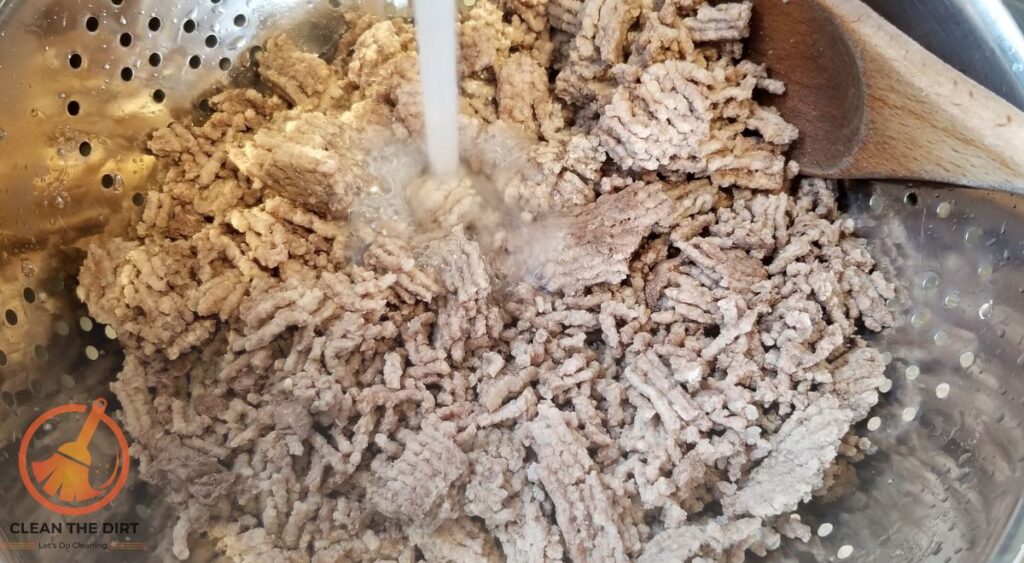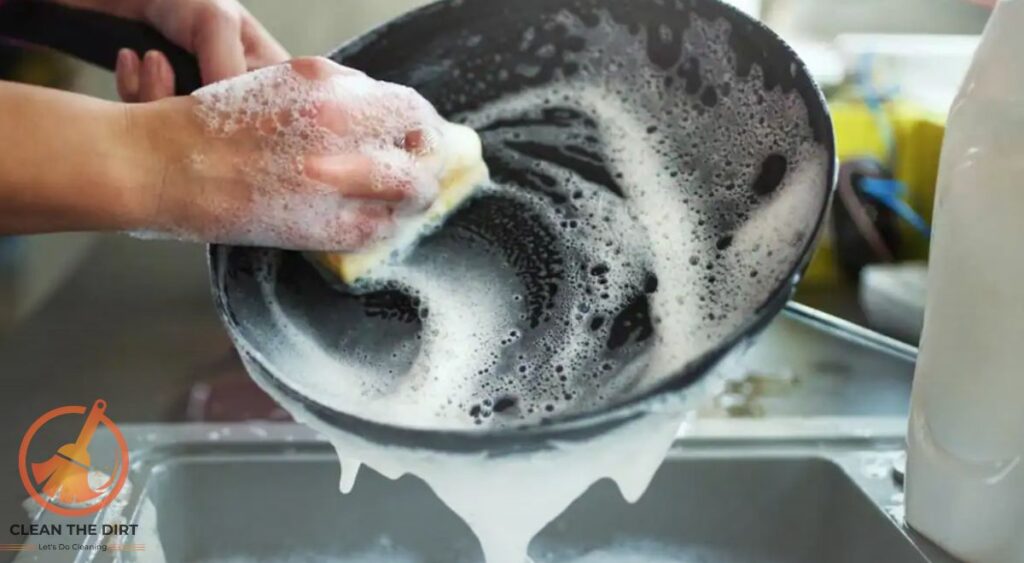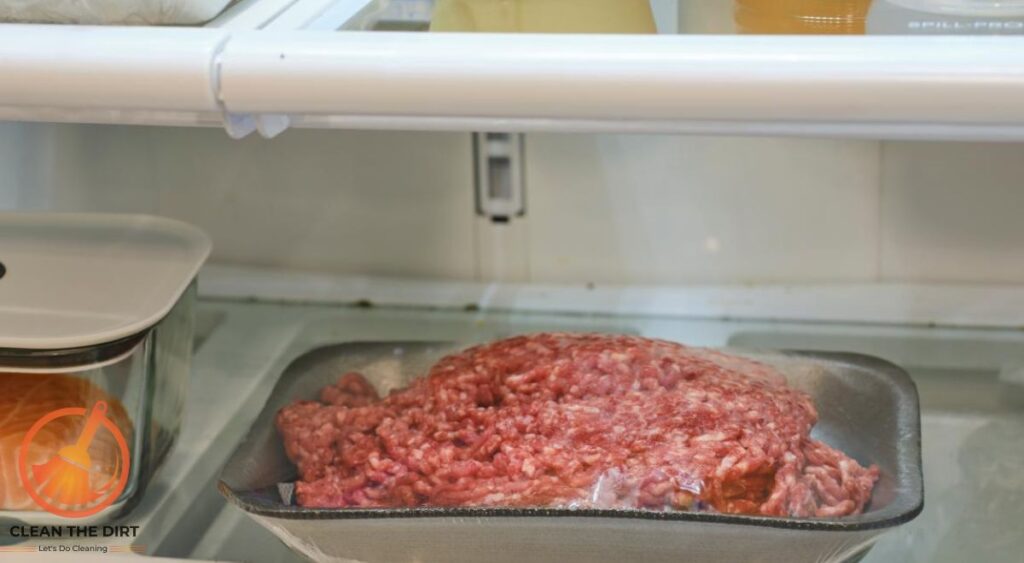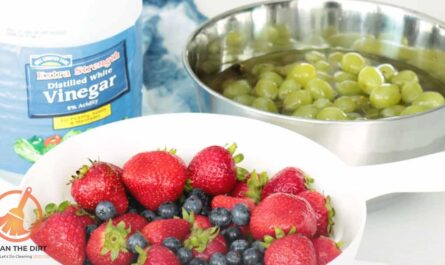Table of Contents
Introduction
Cooking with ground beef is a versatile and delicious option for many meals, from burgers to spaghetti bolognese. Cleaning ground beef properly before cooking is not only about enhancing flavor but also about ensuring food safety. By following the simple yet essential steps provided in this guide on how to clean ground beef, you can significantly reduce the risk of contamination and enjoy your meals with confidence.
Preparing ground beef begins with cleaning ground beef thoroughly. This process involves more than just a quick rinse under water. It’s about inspecting the meat, removing excess fat, and handling it with care to maintain its quality and safety. Whether you’re an expert chef or a beginner in the kitchen, understanding these steps will help you cook ground beef in a way that’s both delicious and safe.
In this guide, we’ll walk through how to clean ground beef step by step, offering practical tips and best practices along the way. By the end, you’ll have the knowledge to handle ground beef with confidence, ensuring every meal you prepare is not only tasty but also safe for you and your family.
Why Cleaning Ground Beef Matters?
Understanding how to clean ground beef properly is crucial for both the flavor and safety of your meals. When you buy ground beef from the store or butcher, it often contains residues from processing, including surface bacteria and excess fat. By cleaning ground beef before cooking, you remove these contaminants and ensure that what you’re serving is not only delicious but also safe to eat.
Cleaning ground beef starts with a visual inspection. Checking for any discoloration or unusual odor can indicate freshness and quality. Next, cleaning ground beef involves removing excess fat. This not only enhances the dish’s flavor but also reduces unnecessary calories and grease.
Moreover, this guide on how to clean ground beef includes rinsing it under cold water to wash away any remaining particles. Patting it dry afterward prevents diluting flavors during cooking and helps achieve a better texture.
By following these steps, you’re not only improving the taste and texture of your dishes but also ensuring that they’re safe for consumption. Taking the time to learn how to clean ground beef effectively is an investment in both your cooking skills and your family’s health.
The importance of proper food handling extends beyond ground beef. Learning techniques like how to clean ground beef ensures not only delicious meals but also safe cooking practices. Similarly, understanding methods for cleaning portobello mushrooms and cleaning vegetables with baking soda can enhance the flavors of various dishes while maintaining food safety standards.
Materials Needed
Before you begin this guide on how to clean ground beef, gather these essential materials to ensure a safe and effective process.
1. Fresh Ground Beef
Start with fresh, high-quality ground beef from a trusted source to ensure the best flavor and safety.
2. Cutting Board
Use a clean cutting board designated specifically for handling raw meats like ground beef. This helps prevent cross-contamination.
3. Knife
A sharp knife for trimming excess fat or dividing the ground beef as needed.
4. Colander or Sieve
Use this to drain excess fat and rinse the ground beef under cold water.

5. Paper Towels
For patting dry the rinsed ground beef to remove excess moisture before cooking.
6. Clean Hands and Apron
Both before and after handling uncooked ground beef, thoroughly wash your hands with soap and water. Wearing an apron helps keep your clothing clean during preparation.
7. Food Thermometer
Essential for checking the internal temperature of cooked ground beef, ensuring it reaches a safe temperature of 160°F (71°C) to destroy harmful bacteria.
By having these materials ready, you’ll be well-prepared to follow the steps for how to clean ground beef effectively, ensuring your meals are safe and delicious for everyone to enjoy.
How to Clean Ground Beef? A Step-by-Step Guide
Learning how to clean ground beef is essential for ensuring safe and delicious meals. Follow these straightforward steps to prepare ground beef for cooking.
Step 1: Inspecting the Meat
Before you begin, inspect the ground beef for any signs of discoloration or unusual odor. This visual check ensures that the meat is fresh and of high quality.
Step 2: Removing Excess Fat
Place the ground beef in a colander or sieve over a bowl. Gently press down on the meat to release excess fat. Alternatively, you can blot the meat with paper towels to absorb the fat.
Step 3: Rinsing and Draining
Rinse the ground beef under cold running water. Use your hands to break up any clumps and ensure thorough rinsing. This step helps to wash away surface bacteria and contaminants.
Step 4: Patting Dry
After rinsing, transfer the ground beef to a clean, dry plate or cutting board. Using paper towels, pat the meat dry to remove any remaining moisture. This step is crucial for preventing the dilution of flavors and achieving a better sear when cooking.
By following these simple steps, you can effectively clean ground beef before incorporating it into your favorite recipes. Practicing proper that how to clean ground beef techniques ensures that you are eating well and you are sensitive about your and your family’s health.
Best Practices for Cleaning Ground Beef
Mastering how to clean ground beef involves more than just basic rinsing. Here are some additional tips and best practices to ensure your ground beef is thoroughly cleaned and safe to cook.
1. Use Fresh Ground Beef
Start with fresh ground beef from a reliable source. This reduces the risk of contamination and ensures better flavor.
2. Handle with Clean Hands
Prevent cross-contamination by giving your hands a thorough wash both before and after handling ground beef.
3. Separate Cutting Boards
Use separate cutting boards, one for raw meats like ground beef and another for fresh produce to avoid spreading bacteria.
4. Avoid Overhandling
Minimize handling of ground beef to maintain its texture and prevent compacting, which can affect cooking results.
5. Store Properly
Store ground beef in the refrigerator at 40°F (4°C) or below and use it within 1-2 days of purchase for the best quality.
6. Cook to Safe Temperatures
Cook ground beef to an internal temperature of 160°F (71°C) to ensure it’s safe to eat. Use a food thermometer for accuracy.
7. Clean Utensils and Surfaces
Clean knives, cutting boards, and countertops with hot, soapy water after handling raw ground beef to prevent cross-contamination.

By incorporating these best practices into your routine, you can confidently prepare ground beef for cooking while ensuring optimal safety and flavor. Knowing how to clean ground beef properly enhances your culinary skills and promotes healthy eating habits.
Moreover, employing methods such as cleaning fruit with baking soda and vinegar and cleaning berries with vinegar helps remove pesticides and prolongs freshness.
Safety Considerations
When learning how to clean ground beef, it’s important to prioritize safety throughout the entire process.
1. Handling Raw Meat
Handle uncooked ground beef only after thoroughly washing your hands with soap and water. This helps prevent the spread of bacteria.
2. Avoid Cross-Contamination
Use separate cutting boards and utensils for raw ground beef and other ingredients, such as vegetables or cooked foods, to avoid cross-contamination.
3. Proper Storage
Store raw ground beef in the refrigerator at 40°F (4°C) or below to prevent bacterial growth. Use it within a day or two of buying it, or freeze it for extended preservation.
4. Thorough Cooking
Cook ground beef to an internal temperature of 160°F (71°C) using a food thermometer. This ensures that harmful bacteria, such as E. coli and Salmonella, are destroyed.
5. Cleaning Surfaces
Clean and sanitize all surfaces, utensils, and countertops that come into contact with raw ground beef using hot, soapy water.
6. Avoiding Temperature Abuse
Do not leave raw ground beef at room temperature for more than two hours. Refrigerate or freeze leftovers promptly.
7. Inspecting Quality
Before cleaning ground beef, inspect it visually for any signs of discoloration or unusual odor, which could indicate spoilage.
By following these safety considerations, you can confidently handle and prepare ground beef while minimizing the risk of foodborne illness. Understanding how to clean ground beef safely, you can cook with confidence, knowing you’re taking important steps to safeguard everyone who enjoys your meals.
Maintenance Tips
Knowing how to clean ground beef properly is essential not only during preparation but also in maintaining a clean and safe kitchen environment.
1. Clean As You Go
After cleaning ground beef, immediately wash utensils, cutting boards, and countertops with hot, soapy water to prevent cross-contamination.
2. Sanitize Regularly
Periodically sanitize kitchen surfaces with a disinfectant to eliminate any lingering bacteria, especially after handling raw meats like ground beef.
3. Organize Refrigerator
Store ground beef in sealed containers or packaging to prevent drips and spills that could spread bacteria. Keep it separate from ready-to-eat foods.
4. Check Temperature Settings
Ensure your refrigerator is set to 40°F (4°C) or below to maintain freshness and prevent bacterial growth in stored ground beef.
5. Inspect for Spoilage
Regularly check ground beef for signs of spoilage, such as discoloration or an off odor. Dispose of any meat that appears questionable.
6. Review Storage Guidelines
Follow recommended storage times for ground beef to maintain quality and safety. After purchase, use within a day or two, or freeze for extended storage.

By incorporating these maintenance tips into your routine, you’ll not only enhance your understanding of how to clean ground beef but also promote a hygienic kitchen environment that supports safe and enjoyable cooking experiences.
Common Mistakes to Avoid
Understanding how to clean ground beef properly involves not only knowing what to do but also being aware of common mistakes that can compromise safety and flavor.
1. Skipping Inspection
Neglecting to visually inspect ground beef before cleaning can lead to using meat that is past its prime or potentially spoiled.
2. Rinsing with Hot Water
Using hot water to rinse ground beef can partially cook it, compromising texture and potentially increasing the risk of bacterial growth.
3. Not Patting Dry
Failing to pat dry rinsed ground beef before cooking can result in excess moisture during cooking, affecting browning and flavor.
4. Cross-Contamination
Using the same cutting board or utensils for raw ground beef and ready-to-eat foods without proper cleaning can spread harmful bacteria.
5. Overhandling
Excessively handling ground beef can cause it to compact, leading to a tougher texture when cooked.
6. Improper Storage
Storing ground beef at temperatures above 40°F (4°C) or leaving it at room temperature for extended periods can promote bacterial growth.
7. Ignoring Food Safety Guidelines
Not cooking ground beef to the recommended internal temperature of 160°F (71°C) can pose a risk of foodborne illness.
By being mindful of these common pitfalls and practicing proper techniques for learning how to clean ground beef, you can enhance the safety and flavor of your meals, ensuring a satisfying dining experience for all.
Conclusion
Mastering how to clean ground beef is an essential skill for any home cook who values both safety and flavor in their meals. By following the simple yet crucial steps outlined in this guide, you can ensure that your ground beef is thoroughly cleaned before cooking, removing any contaminants and excess fat that could compromise both taste and health.
Remember, cleaning ground beef begins with careful inspection and ends with proper storage and cooking to safe temperatures. These steps not only enhance the quality of your dishes but also reduce the risk of dietary illnesses, allowing you to cook with confidence and serve meals that are both delicious and safe for your family and friends.
By incorporating these practices into your culinary routine, you can elevate your cooking experience and ensure that every meal is prepared with care and attention to cleanliness. For more tips on food preparation and safety, explore our articles on how to clean apples with baking soda. It ensures that your snacks are both nutritious and safe.
The table below highlights key practices for properly cleaning and handling ground beef, ensuring safety and enhancing meal quality.
| Aspect | Correct Practice | Incorrect Practice |
|---|---|---|
| Initial Inspection | Inspect ground beef for freshness, bright red color, and no off smells | Using ground beef without inspecting for spoilage or discoloration |
| Fat Removal | Use a colander or sieve to press and drain excess fat | Skipping the fat removal process, leading to greasy, unhealthy meals |
| Rinsing Method | Rinse ground beef under cold running water | Rinsing with hot water, which can partially cook the meat and spread bacteria |
| Drying Method | Pat the ground beef dry with paper towels to remove excess moisture | Not drying ground beef, resulting in soggy texture and diluted flavors |
| Cross-Contamination Prevention | Use separate cutting boards and utensils for raw meat and other foods | Using the same cutting boards and utensils for raw meat and other ingredients |
| Storage Practices | Store ground beef in the refrigerator at 40°F (4°C) or below, or freeze for long-term storage | Storing ground beef at room temperature or above 40°F (4°C), increasing the risk of bacterial growth |
| Cooking Temperature | Cook ground beef to an internal temperature of 160°F (71°C) | Undercooking ground beef, which can lead to foodborne illnesses |
| Cleaning Frequency | Clean all utensils, cutting boards, and surfaces with hot, soapy water immediately after use | Delaying the cleaning of utensils and surfaces, leading to potential cross-contamination |
| Hand Washing | Wash hands thoroughly with soap and water before and after handling ground beef | Neglecting to wash hands, spreading bacteria from raw ground beef to other surfaces and foods |
| Storage Duration | Use ground beef within 1-2 days of purchase or freeze it for longer storage | Keeping ground beef in the fridge for too long, increasing the risk of spoilage |
Whether you’re preparing burgers, tacos, or spaghetti sauce, understanding how to clean ground beef properly sets the foundation for enjoyable and wholesome cooking experiences. Incorporate these practices into your kitchen routine, and you’ll be well-equipped to create flavorful dishes that everyone will love.
Frequently Asked Questions (FAQs) for How to Clean Ground Beef?
Why is it important to clean ground beef before cooking?
Cleaning ground beef helps remove surface bacteria, excess fat, and contaminants, ensuring safer and more flavorful meals.
How should I inspect ground beef before cleaning?
Look for any discoloration, off odors, or slimy texture, which can indicate spoilage. Fresh ground beef should be bright red and firm to the touch.
Do I need to rinse ground beef before cooking?
Yes, rinsing ground beef under cold water helps remove residual bacteria and surface contaminants. Pat it dry with paper towels afterward to enhance cooking results.
Can I store ground beef after cleaning?
Yes, store cleaned ground beef in the refrigerator at 40°F (4°C) or below and use it within 1-2 days. For longer storage, freeze it in airtight containers or freezer bags.
How do I know when ground beef is cooked properly?
Use a food thermometer to ensure ground beef reaches an internal temperature of 160°F (71°C). This temperature kills harmful bacteria like E. coli and Salmonella.
What should I do if I accidentally cross-contaminate surfaces with raw ground beef?
Immediately wash affected surfaces, utensils, and hands with hot, soapy water. Disinfect countertops and cutting boards to prevent the spread of bacteria.
Can I use the same cutting board for ground beef and other foods?
It’s best to use separate cutting boards—one for raw meats like ground beef and another for fresh produce and cooked foods—to prevent cross-contamination.
Are there any alternatives to rinsing ground beef?
Some prefer not to rinse ground beef and instead pat it dry with paper towels to remove excess moisture and enhance browning when cooking
You May Also Like: How to Clean a Turkey Before Cooking? Expert Tips and Tricks




